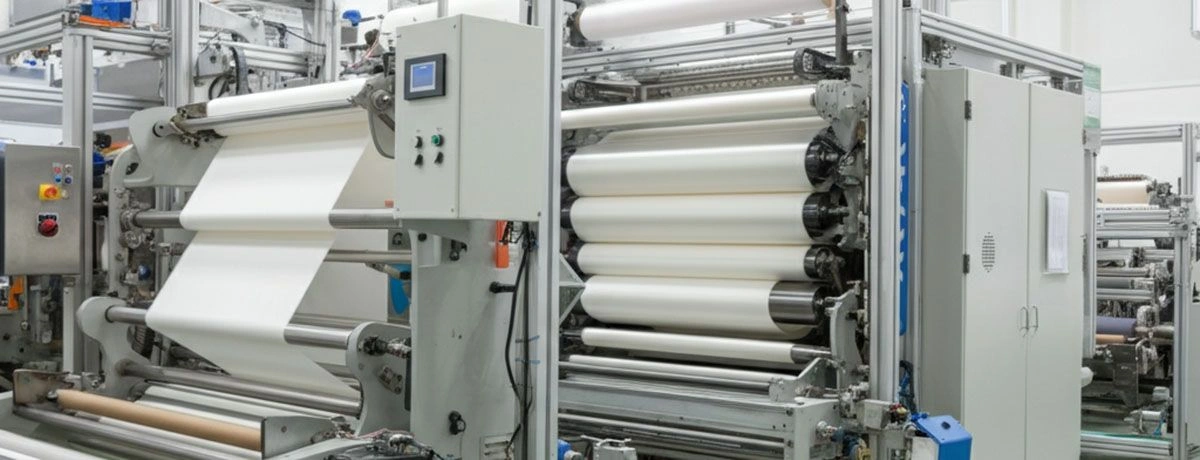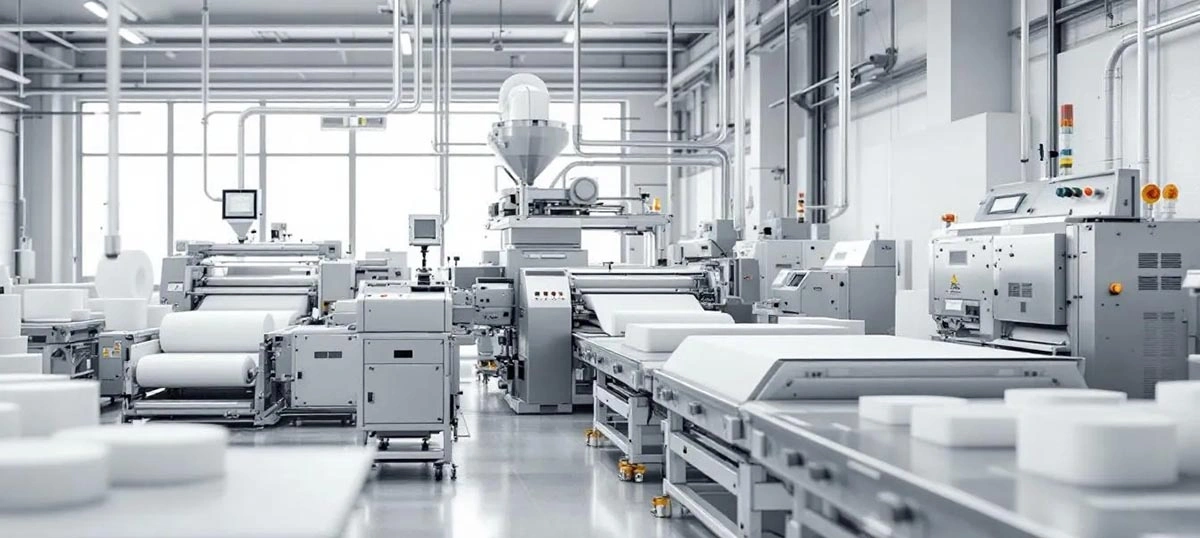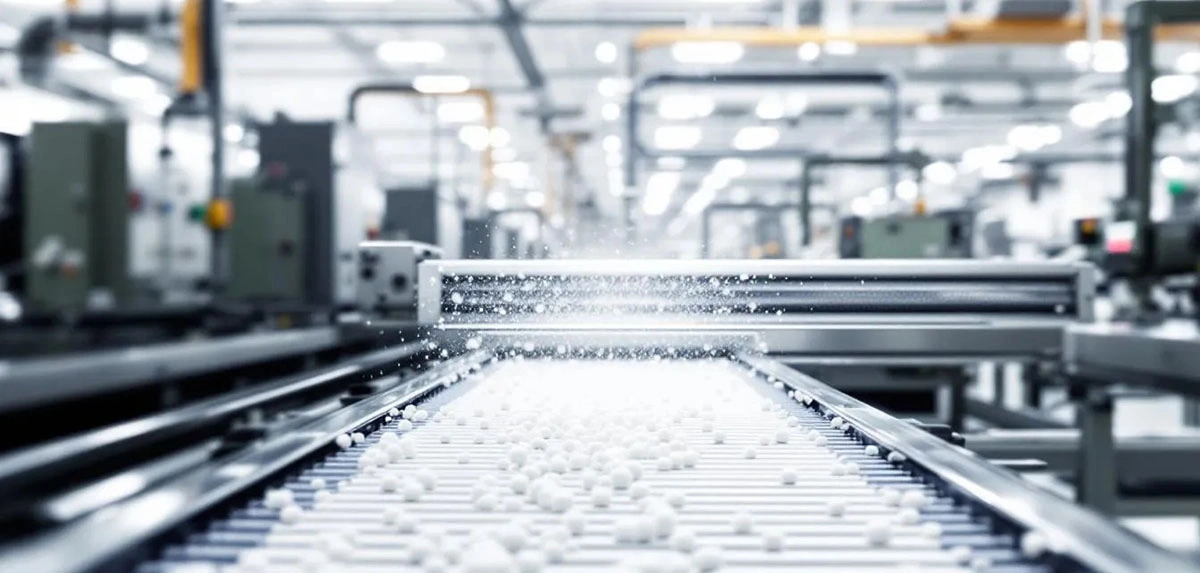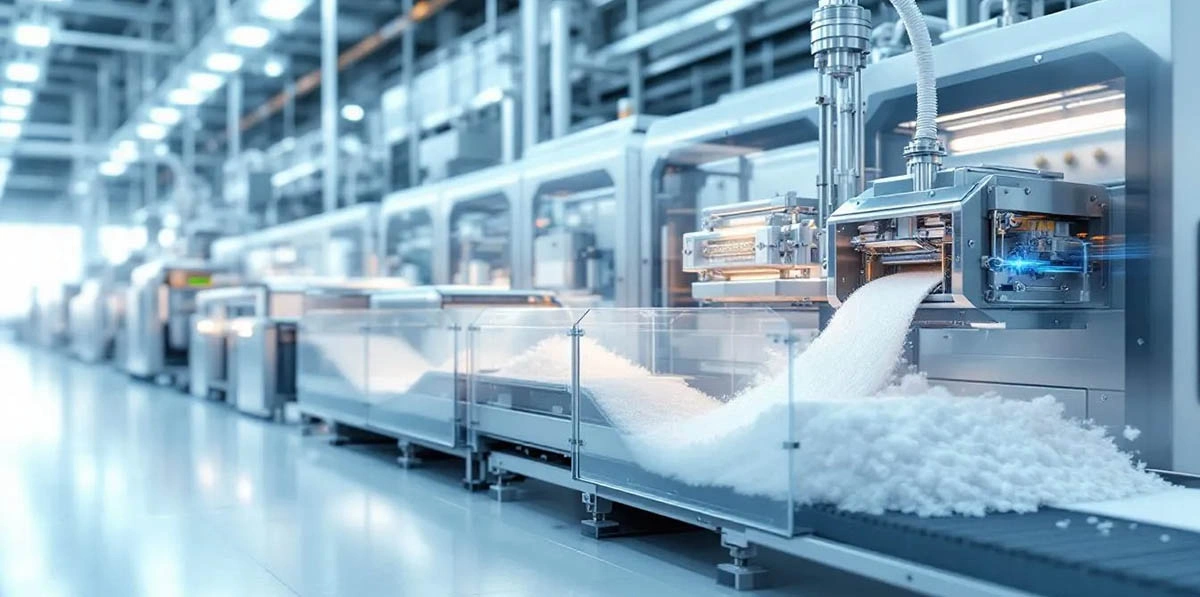Top Non Woven Manufacturing Processes Explained

Non woven manufacturing creates fabrics by bonding or interlocking fibers, rather than weaving or knitting. This versatile method caters to diverse industries, including healthcare and automotive. This article explores the processes, materials, sustainability, and applications of non woven manufacturing.
Key Takeaways
-
Nonwoven fabrics are essential in various industries due to their customizable properties, achieved through unique manufacturing processes like spun bond, melt blown, and needle punching.
-
Sustainability is a key focus in nonwoven manufacturing, with increasing use of recycled materials and energy-efficient technologies promoting environmental responsibility.
-
The global nonwoven fabrics market is projected to grow significantly, driven by rising demand in sectors such as healthcare and automotive, especially in the Asia-Pacific region.
Overview of Non Woven Manufacturing

Nonwoven fabrics play a crucial role in various industries by providing versatile solutions for numerous applications. Unlike traditional woven or knitted fabrics, nonwovens are created through methods that bond or interlock fibers, allowing for significant customization in terms of texture, strength, and absorbency. This distinctive production approach enables nonwovens to meet the specific needs of diverse sectors, from healthcare to automotive, enhancing their functionality and appeal.
Nonwoven fabric production offers extensive customization in texture, strength, and absorbency. This adaptability has rendered non woven fabric essential in various industries, providing advantages that traditional wovens lack.
We will explore the raw materials and key processing that define nonwoven manufacturing.
Raw Materials for Non Wovens
The foundation of any nonwoven fabric lies in its raw materials. Manufacturers are increasingly integrating recycled materials into their products, significantly lowering the waste generated from production. This shift towards using recycled fibers not only supports a circular economy but also minimizes the need for new raw materials, making the production process more sustainable. Focusing on circular economy principles, nonwoven producers enhance sustainability by designing products for reuse and recycling.
Synthetic fibers are widely used in nonwoven production, valued for their strength and versatility. These fibers, often derived from polymers like polypropylene and polyester, create fabrics suited for a variety of applications, from medical supplies to construction materials. On the other hand, natural fibers are becoming increasingly popular, offering biodegradable options for environmentally conscious consumers. Materials such as cotton and bamboo provide a more sustainable alternative without compromising on the durability and functionality of the nonwoven fabric.
The use of advanced materials in nonwoven manufacturing ensures that the resulting products are both durable and functional. Whether it’s for building materials, personal care products, or industrial applications, the choice of raw materials plays a critical role in determining the performance and sustainability of nonwoven fabrics.
Next, we explore the key processes involved in nonwoven production, beginning with the spun bond process.
Key Processes in Non Woven Production
The creation of nonwoven fabrics relies on a series of essential processes, each playing a vital role in shaping the distinctive characteristics of the final material. One of the most prominent methods is the spun bond process, which includes:
-
Extruding molten polymers through spinnerets to create continuous filaments.
-
Laying these filaments onto a moving conveyor to form a web.
-
Utilizing high-speed spinning and drawing techniques to create a uniform arrangement of fine fibers.
In the spun bond process, fibers are laid down in a random orientation, enhancing the fabric’s strength and structure. This web formation stage is crucial, as it determines the integrity and performance of the nonwoven fabric.
Understanding these key processes allows us to appreciate the complexity and precision in nonwoven manufacturing. Now, we’ll delve into the specifics of the spun bond process, starting with web formation.
Spun Bond Process

The spun bond method is a cornerstone in nonwoven manufacturing, creating fabrics by extruding thermoplastic polymers into continuous filaments. These filaments are then laid down to form a web, which undergoes various bonding techniques to achieve the desired properties.
This section will explore the intricacies of web formation, thermal bonding, and the diverse applications of spun bond fabrics.
Web Formation
Web formation is a critical stage in the spun bond process, where continuous filaments are extruded from thermoplastic polymers and laid down to form a web. Techniques like dry laying, wet laying, and meltblown methods can be employed to create the base structure of nonwoven fabrics. During this stage, fine fibers are arranged in a random pattern, ensuring optimal web integrity and uniformity.
The process involves drawing and depositing fine filaments on a conveyor belt, where they are arranged to ensure optimal web integrity. This random fiber orientation enhances the strength and structure of the nonwoven fabric, making it suitable for various applications.
Once the web is formed, the next step is bonding the fibers together, typically through thermal bonding, resulting in a bonded structure.
Thermal Bonding
Thermal bonding is a crucial process in spun bond manufacturing, where heat and pressure are applied to fuse fibers together. This method enhances the fabric’s durability and mechanical strength, making it suitable for demanding applications. Thermal bonding melts the fibers to create a strong bond, ensuring the nonwoven fabric’s integrity and longevity.
The application of heat and sometimes pressure in thermal bonding results in a cohesive fabric with improved mechanical characteristics. This process is essential for achieving the desired properties of spun bond fabrics, such as increased strength and durability. In spun bond processes, thermal bonding and heat sealing are key steps that significantly enhance the fabric’s performance and suitability for various applications.
Next, we explore the diverse applications of spun bond fabrics, which benefit from the enhanced durability and mechanical strength imparted by thermal bonding. These applications span various industries, highlighting the versatility and importance of spun bond nonwovens.
Applications of Spun Bond
Spun bond fabrics are significant in various industries due to their lightweight and durable characteristics. Common applications include medical textiles such as face masks and hygiene products like diapers. The lightweight and strong properties of spun bond nonwovens make them ideal for use in baby diapers, surgical masks, and filtration products.
These materials are widely utilized in the production of protective equipment, enhancing protection and hygiene in healthcare and personal care sectors. The applications of spun bond nonwovens significantly enhance protection and hygiene in healthcare and personal care sectors.
With a better understanding of the spun bond process, let’s move on to another crucial method in nonwoven manufacturing: the melt blown process.
Melt Blown Process

The melt blown technique is another pivotal process in nonwoven manufacturing, producing fabrics by extruding molten polymer through a die. This results in fine fibers that are rapidly cooled and collected on a surface, creating nonwoven fabrics with unique properties.
This section will delve into fiber formation, barrier properties, and the common uses of melt blown fabrics.
Fiber Formation
The melt blown process is notable for its ability to produce very fine fibers, which contribute to the unique characteristics of the resulting nonwoven fabric. This technique involves:
-
Utilizing high-velocity air to transform molten thermoplastic resin into microfibers
-
Rapidly cooling and solidifying the microfibers
-
Using a high-pressure extrusion method to ensure the formation of fine fibers essential for specific applications.
In the melt blown technique, fibers are formed by forcing molten polymer through high-pressure nozzles, rapidly cooling and solidifying. This creates a web with unique filtration properties, making melt blown fabrics highly effective for applications requiring fine particulate capture. The fine fibers produced through this method highlight the advanced capabilities of nonwoven manufacturing.
Barrier Properties
Melt blown materials exhibit excellent barrier properties, making them suitable for applications such as filtration, where fine fibers help trap particles effectively. These nonwovens are particularly effective for use in medical and industrial settings, thanks to their superior barrier properties. The ability to block contaminants makes melt blown fabrics ideal for personal protective equipment and filtration systems.
Nonwovens created through the melt blown process exhibit excellent barrier properties, making them highly effective in filtration applications. This manufacturing technique produces fine fibers through high-pressure extrusion, resulting in materials with superior barrier capabilities, crucial for applications demanding high levels of protection and filtration efficiency.
Common Uses
Melt blown fabrics are predominantly utilized in:
-
Filter media, especially for surgical masks and various liquid and gas filtration applications, including filtration media.
-
The medical sector, as key components in disposable surgical gowns and sterile packaging.
-
Sanitary products such as feminine hygiene items and adult incontinence pads.
The versatility of melt blown fabrics extends to oil spill cleanup efforts, where their absorbent properties are highly effective. In clothing, melt blown fabrics serve in thermal insulation, industrial disposable clothing, and synthetic leather substrates, showcasing their water repellent properties.
The diverse applications of melt blown fabrics demonstrate their importance in various sectors, from healthcare to environmental protection. We will now explore the needle punched process, another key method in nonwoven manufacturing.
Needle Punched Process
The needle punched method is significant in nonwoven manufacturing as it provides a way to create cohesive fabrics without adhesives. This process involves interlocking fibers through repeated barbed needle penetration, creating a durable fabric structure.
This section will explore mechanical bonding, high loft fabrics, and the industry applications of needle punched nonwovens.
Mechanical Bonding
Mechanical bonding is achieved by using barbed needles to punch through a fiber web, enabling the fibers to entangle and form a cohesive material. During this process, needles penetrate the fiber mass, creating a stable structure without the use of adhesives. Needle punching uses barbed needles to entangle fibers, enhancing the fabric’s strength without the need for adhesives.
The penetration of needles through the fiber web significantly enhances the durability and structural integrity of the resulting fabric. This method is essential for creating nonwoven fabrics that are robust and functional, suitable for various applications.
With a strong foundation in mechanical bonding, let’s explore the creation of high loft fabrics through needle punching.
High Loft Fabrics
Needle punching can produce high loft fabrics that provide effective sound and thermal insulation properties. These fabrics are characterized by their thickness and softness, and are specifically engineered for applications requiring sound absorption and acoustic insulation. High loft nonwovens are ideal for use in acoustic panels, offering excellent sound absorption capabilities that are crucial in various settings, from industrial to commercial spaces.
High loft fabrics created via needle punching are particularly effective for insulation applications due to their excellent thermal properties. These fabrics are often used in applications where both sound and thermal insulation are required, such as in automotive interiors and building construction. The combination of thickness and durability makes high loft fabrics an essential component in many industries.
Industry Applications
Needle punched nonwovens are widely utilized in industries including automotive, construction, and filtration systems. In the automotive industry, these fabrics are used for upholstery and acoustic panels, providing both aesthetic and functional benefits. The construction industry relies on needle punched nonwovens for their strength and durability, making them suitable for applications such as geotextiles and roofing materials.
The versatility of needle punched nonwovens extends to personal care products and filtration systems. These fabrics are used in various sectors due to their robustness and adaptability, making them suitable for a wide range of specific jobs, personal protection, and technologies.
As we transition to discussing sustainability in nonwoven manufacturing, it’s clear that needle punched fabrics play a crucial role in multiple industries.
Sustainability in Non Woven Manufacturing
The non woven manufacturing sector is increasingly adopting sustainable practices to align with environmental standards and consumer demand. Innovations in nonwoven fabrics include the introduction of biodegradable options and the use of recycled fibers to reduce environmental impact.
This section will explore the use of recycled fibers, energy-efficient technologies, and circular economy principles in nonwoven manufacturing.
Use of Recycled Fibers
Manufacturers often utilize recycled materials in nonwoven fabric production, significantly lowering the environmental impact of sourcing virgin fibers. Integrating recycled fibers into their products, manufacturers mitigate environmental impact and promote resource conservation. Circular economy strategies enhance material reuse, reducing reliance on virgin resources.
The incorporation of recycled fibers reflects a strong commitment to sustainability within the nonwoven industry. These practices support the creation of advanced materials that meet the evolving needs of consumers and industries alike. By focusing on recycled fibers, nonwoven manufacturers contribute positively to environmental sustainability and resource efficiency.
Energy-Efficient Technologies
Advanced technologies in nonwoven manufacturing are being implemented to reduce energy consumption during production. Innovations like the Energy First initiative aim to create energy-efficient manufacturing processes that significantly lower carbon emissions and resource usage. These technologies enhance the efficiency of nonwoven production, aligning with global sustainability goals.
The adoption of energy-efficient technologies not only reduces the environmental footprint of nonwoven manufacturing but also improves the economic viability of production processes. Investing in advanced materials and technology allows the industry to achieve higher efficiency and lower costs, benefiting both manufacturers and consumers.
As we continue, we’ll discuss the implementation of circular economy principles in nonwoven manufacturing.
Circular Economy Principles
Non woven manufacturers are implementing practices that support material reuse and recycling, aligning with circular economy strategies. Circular economy principles focus on sustainability by emphasizing the reuse and recycling of materials in manufacturing processes. These practices lead to reduced environmental impact and contribute positively to sustainable development in the textile industry.
Incorporating circular economy strategies, nonwoven manufacturers reduce waste and enhance production efficiency. This approach supports a more sustainable and resilient nonwoven fabric market, meeting evolving consumer and industry needs.
The commitment to circular economy principles is a testament to the industry’s dedication to sustainability.
Market Dynamics and Growth Opportunities
The nonwoven fabrics market is projected to expand significantly, driven by increasing demand across various industries. With a compound annual growth rate (CAGR) of 6.7%, the market is expected to grow from $58.4 billion in 2023 to $104.1 billion by 2033.
This section will explore global market trends, regional expansion opportunities, and emerging opportunities in nonwoven manufacturing.
Global Market Trends
The global nonwoven fabrics market is influenced by significant growth trends, particularly in regions such as North America and Asia-Pacific. Asia-Pacific is expected to dominate the nonwoven fabrics market due to:
-
A growth rate of 5.6%
-
Rising demand from healthcare, construction, automotive, and packaging sectors
-
A robust industrial base
-
An expanding consumer market These factors drive the demand for nonwoven materials in the region.
North America is projected to experience the fastest growth rate in the nonwoven fabrics market, driven by high healthcare spending and demand. The evolving needs of these regions highlight the dynamic nature of the nonwoven industry, with significant opportunities for growth and innovation.
Next, we explore the regional expansion opportunities in the nonwoven market.
Regional Expansion
Asia-Pacific is identified as the largest regional market for nonwoven fabrics, driven by heightened demand across sectors such as hygiene, medical, and construction. This region accounted for 43.1% of the global nonwoven fabrics market in 2023, reflecting its significant demand across various sectors. The dominance of Asia-Pacific in the nonwoven fabrics market is expected to continue, with a CAGR of 5.6%.
The increasing production capacity and demand for hygiene products in Asia-Pacific highlight new opportunities for growth. As the market continues to expand, manufacturers are likely to invest in advanced materials and technologies to meet the evolving needs of consumers and industries.
The regional expansion in the nonwoven market underscores the global potential of this dynamic industry.
Emerging Opportunities
Technological advancements in nonwoven manufacturing are expected to:
-
Lower production costs and improve product quality, boosting market growth.
-
Create new markets through innovations like nanofiber integration.
-
Meet the rising demand for lightweight nonwoven materials in the automotive industry, aiming to enhance fuel efficiency and reduce CO2 emissions.
The convergence of technological innovations and evolving industry demands presents substantial opportunities for growth in nonwoven manufacturing. As nonwoven manufacturers continue to innovate and adapt to new challenges, the industry is poised for significant expansion and success.
With a focus on advanced materials and sustainability, the future of nonwoven manufacturing looks promising.
Key Players in Non Woven Manufacturing
The nonwoven industry is shaped by numerous influential companies that contribute innovative products and technologies. This section highlights some of the key players in nonwoven manufacturing, including MH and other leading manufacturers.
MH
MH is involved in non-woven manufacturing, contributing to the industry’s growth with its innovative approaches and commitment to quality. By leveraging advanced materials and technologies, MH continues to set standards in nonwoven fabric production, meeting the evolving needs of various industries.
Other Leading Manufacturers
Johns Manville Corporation, a subsidiary of Berkshire Hathaway, has a notable presence in the nonwoven market with a diverse product portfolio and a revenue exceeding $3 billion. Glatfelter Corporation, founded in 1864, is a leader in engineered materials, focusing on various nonwoven applications and achieving approximately $1.4 billion in revenue. This company, among others, plays a critical role in advancing the nonwoven industry with their innovative products and technologies.
Several manufacturers focus on creating specialized nonwoven fabrics that cater to specific market needs, such as medical and hygiene products. These leading manufacturers continue to drive the industry forward, contributing significantly to the market with their diverse product portfolios and commitment to sustainability.
Summary
In summary, nonwoven manufacturing is a dynamic and innovative industry that plays a crucial role in various sectors, from healthcare and hygiene to automotive and construction. The diverse processes involved in nonwoven fabric production, such as the spun bond, melt blown, and needle punched methods, each contribute unique properties and benefits to the final product. By leveraging advanced materials and sustainable practices, the industry continues to meet the evolving needs of consumers and industries.
The market dynamics and growth opportunities in nonwoven manufacturing highlight the industry’s potential for significant expansion and success. With key players like MH and other leading manufacturers driving innovation and sustainability, the future of nonwoven fabrics looks promising. As we move forward, the commitment to sustainability and technological advancements will continue to shape the landscape of nonwoven manufacturing, inspiring new opportunities and innovations.
Frequently Asked Questions
What are nonwoven fabrics?
Nonwoven fabrics are produced by bonding or interlocking fibers using various methods, such as mechanical, thermal, or chemical processes, rather than traditional weaving or knitting. This unique structure gives them distinct properties and applications.
What raw materials are used in nonwoven manufacturing?
Nonwoven manufacturing primarily employs synthetic fibers such as polypropylene and polyester, along with natural fibers like cotton and bamboo, increasingly incorporating recycled materials. This blend enhances sustainability and performance in various applications.
What is the spun bond process?
The spun bond process entails extruding molten polymers into continuous filaments that are subsequently laid down to create a web, which is bonded using thermal methods. This technique is essential for producing durable and high-performance nonwoven fabrics.
What are the barrier properties of melt blown fabrics?
Melt blown fabrics possess exceptional barrier properties that make them highly effective for filtration applications and personal protective equipment, specifically due to their ability to capture fine particulates.
How is sustainability being addressed in nonwoven manufacturing?
Sustainability in nonwoven manufacturing is being addressed through the use of recycled fibers, energy-efficient technologies, and adherence to circular economy principles, all of which significantly reduce environmental impact. This proactive approach not only enhances ecological responsibility but also promotes long-term viability in the industry.
Contact MH
MH offer non woven fabrics. Please contact us for more details or inquiries. We're here to help!


